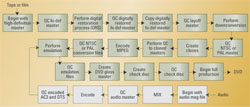THX certification
THX was born 20 years ago, out of filmmaker George Lucas’ vision to improve the quality of sound throughout the film production chain. Still, there remains confusion about what THX does and how its certification programs add value to the production and presentation of entertainment content.
A brief history
In 1982, Lucas hired an audio scientist, Tomlinson Holman, to develop specifications for Lucas’ audio mixing facilities at Skywalker Ranch in northern California. Holman was given one year to study sound technologies and processes throughout the film production chain — from the movie set to the cinema — with the goal of improving cinematic sound production for Lucas’ next film, “Star Wars Episode VI: Return of the Jedi.”
During his year of research, Holman found that the technology in most professional mixing rooms and commercial cinema auditoriums hadn’t seen improvements since the 1950s. In fact, the Hollywood studios hadn’t built a professional audio mixing room since the end of World War II. The result? In most facilities, the quality of equipment and acoustics was so poor that it was impossible for filmmakers, re-recording mixers and sound designers to hear the detail in their sonic presentations.
After the Skywalker Sound audio facilities were completed, Lucas and Holman started to push the THX standards out to commercial cinemas and professional mixing rooms, as well as to home entertainment products.
THX, Dolby and DTS
Two decades after THX was founded, it remains a popular misconception among media professionals and consumers that THX, Dolby and DTS offer competing sound formats. Actually, this isn’t the case. In fact, THX coexists with Dolby or DTS in thousands of professional recording and mixing facilities, cinemas, and home entertainment components. Dolby provides technology for encoding and decoding audio information on film, DVDs, music, and consumer and professional equipment. Meanwhile, THX sets standards for equipment performance and the physical design of professional mixing and presentation environments.
Get the TV Tech Newsletter
The professional video industry's #1 source for news, trends and product and tech information. Sign up below.
For broadcast media professionals, it provides specifications for the design of multichannel recording, screening and mixing rooms. One of these certification programs is THX pm3, which stands for “professional multichannel mixing and monitoring.” The program focuses on specifications for the design of professional studios that produce non-theatrical audio presentations, such as DVD and other 5.1 soundtracks, video games, and programs for television and multimedia distribution.
The certification creates a standardized environment at production facilities to make sure the quality and integrity of the audio and visual content is always delivered to audiences. The program defines and enforces standards for room acoustics, background noise and sound isolation, and loudspeaker and monitor placement and performance. THX even sets guidelines for lighting levels and operator viewing angles within the room itself to ensure the content creator’s vision is faithfully and consistently delivered.
Standards for broadcast quality
With an increasing amount of multichannel programming material being created for broadcast, having a consistent monitoring environment is an advantage to editors, engineers and producers alike. In every THX certified environment, whether it’s a commercial cinema, screening room, dubbing stage, mixing room or transfer suite, standards specify everything that might influence the monitoring accuracy. It specifies the audio bandwidth, linearity, distortion, signal/noise ratio and maximum output of the audio equipment, in addition to the placement and setup calibration of the visual equipment and the seating placement. The room acoustics are also specified for maximum allowable local and intrusive noise, appropriate high and mid-band reverberation, appropriate level and delay of first-arriving reflections, and control of bass modes. The visual environment is specified for monitor position and stray light control. For instance, in a small recording or mixing room, reverberation decay must stay within +/- 2dB in the middle octaves, with an RT60 target of 2- to 4ms. The room must be free of first reflections from the front speakers that fall with 12ms or 12dB of the sound first arriving at the operator’s location. The room must also be free of intrusive noise at NC25 or better.
The audio system components themselves must be chosen from a list of THX-approved products — which includes speakers from Mackie Designs, Genelec and JBL — and installed and calibrated to exact standards. System bass management and bass and LFE levels must meet precise requirements. The video monitors must be of broadcast quality and properly calibrated. Finally, the viewing environment must meet ITU and SMPTE requirements for light level and color as well as image position and size.
Over the last few years, pm3 rooms have been used to prepare many programs for television shows, from sitcoms to network movies-of-the-week. The pm3 program provides media professionals a listening and viewing environment that is as transparent as possible. Editors and producers know that the visual detail and sonic presentation will be maintained when they transfer projects between THX pm3 certified facilities, allowing critical judgments to be made regardless of the room or facility.
John Dahl is the technical product marketing manager for THX.

Figure 1. THX Digital Works engineers perform extensive quality testing to ensure that the DVDs produced remain as close to theater quality as possible. Click here to see an enlarged diagram.
THX Digital Works: Mastering and QC services for DVD production
What does it mean when a DVD is marked “THX Certified”? Originally founded to master and certify film titles on the laserdisc format, the THX Digital Works division in Burbank, CA, works closely with filmmakers and studios to ensure that DVD content remains true to the original color palette and sound presentation of the theatrical releases. The company provides project management and quality control (QC) services for DVD production. This past year, THX Digital Works mastered and certified a number of DVD projects, including “T2: Extreme DVD” and “The Adventures of Indiana Jones” box set.
THX engineers start by helping the filmmaker and/or DVD producer select the master elements that will be used in the DVD release when the originals are not available. If the studio has a release print or interpositive print available that’s in “pretty good” shape, the engineers will work with the studio and/or director to decide which element will make a DVD that more closely matches the director’s original vision.
Following the transfer to an HD master, THX technicians begin the certification process, applying a variety of QC services to ensure the visual images and soundtrack are not degraded during DVD production. They closely monitor and set guidelines for the downconversion, remove dirt and scratches, review the compressed video and audio, and carefully analyze the disc data through emulation. Figure 1 outlines the steps involved in a typical DVD production and THX certification.
The goal of THX certification is to create a DVD presentation that’s faithful to the artist or content creator’s vision in the mixing room.
